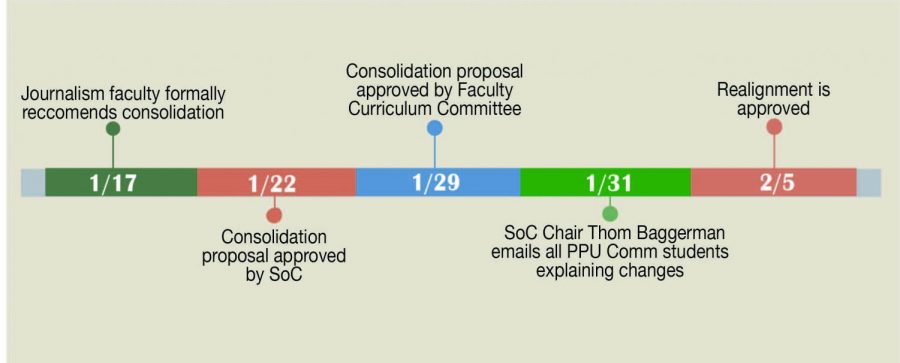School of Comm. restructures journalism degree
February 6, 2018
For students entering Point Park in the fall of 2019, the number of majors offered by the School of Communication will be fewer by four.
In a consolidation passed Monday by the faculty assembly, the existing broadcast reporting, environmental journalism, journalism, mass communication and photojournalism majors will be phased out in favor of a new, restructured bachelor of arts in journalism.
According to Christopher Rolinson, associate professor of photojournalism, the change comes on the heels of a decades-long consideration of integrating multi-platform reporting into the journalism curriculum.
“We’re looking at what we believe are the strongest trends that are going to get you the most opportunities to do that [multiplatform reporting],” Rolinson said Thursday in his office. “What we’ve looked at is we wanted to make sure that every student that was leaving here had a significant journalism experience across all five of those majors.”
Rolinson said the move is in line with what larger journalism programs have been doing in recent years. The official proposal cites “a nationwide, three-decade shift from media-specific degree programs to profession-focused programs.”
The restructured program, consisting of 125 credits, combines the specialized elements of all five of the existing majors with the general requirements of the School of Communication.
The journalism faculty, chaired by Tim Hudson, passed their initial proposal on to the School of Communication Jan. 17. The journalism faculty consists of Hudson, Rolinson, Aimee Dorsten, Helen Fallon, Steve Hallock and Bill Moushey. Only Fallon voted against the measure.
Fallon’s primary reasoning is what she perceives as a rush to change without consulting industry professionals. Fallon said the restructuring comes from an “academic perspective.”
“We didn’t ask hiring managers what they want in a student ready for their TV, radio station, online platform,” Fallon said. “If that information would come back and say everyone should learn everything, then we’d have to take a look at it. I don’t think we did that.”
The initial review of the broadcast reporting degree – which recommended the switch – consulted with a dean from a Florida university and four Point Park adjuncts: Maria Kakay, Gina Catanzarite, Nick Matoney and Susan Koeppen. Every five years, each degree undergoes an evaluation by faculty groups to ensure quality. While the reporting degree consulted with those professionals, Fallon said no working professionals were consulted on the restructuring.
In its proposal to the faculty assembly, the journalism department explains the rationale behind the restructuring as a shift in response to a changing industry and a paradigm shift in academia away from medium-specific majors.
“The changes will align the majors to better reflect the current realities, challenges and trajectories of the profession,” the proposal reads in part. “[The changes] also align our program with the offerings of other academic institutions and best practices in the field. Currently, we offer too varied a group of journalism majors. Competing institutions generally offer a unified journalism major, focusing on the profession rather than mode of delivery.”
The adoption signals the journalism faculty’s intent to compete with programs offered at larger universities. In its research, the journalism faculty identified Penn State, Indiana University of Pennsylvania, Slippery Rock and California University of Pennsylvania as regional competition.
For his part, Rolinson pointed to the faculty-to-major ratio as part of the reasoning for the switch.
“We’re offering the same things [as the current majors do] just in a more organized and modern way,” Rolinson said. “If you think about this in terms of how the school is structured, there are six people in the journalism section and there are five majors.”
There is room for choices within the major requirements, such as between on-camera and radio announcing courses and a choice between specialized advanced reporting courses. Any chosen and prescribed specialization would be limited to 12 credits, or four classes, as major electives. While a student could create their own specialization, there are no formalized concentrations in the proposal.
Rolinson said there was a consideration for concentrations within the journalism degree, as the School of Communication already allows for a graphic design concentration in its multimedia degree.
“I think at the end of the day we decided for simplicity’s sake and for just a little bit more of a class scheduling efficiency that we would allow that to be an advisor sort of relationship,” Rolinson said. “If you wanted a specialization in photojournalism, you have the journalism curriculum and through advising we would work out what courses you should take. This gives you an incentive to do that.”
Upon enrollment, each student is assigned a student success coordinator tasked with scheduling and a faculty advisor, whose role is to assist students in building a path toward employment.
According to Fallon, students often fail to forge that connection with their faculty advisor.
“Students do not have to come and see me, and most don’t,” Fallon said. “I email all of my advisees [to remind them to] register, check your curriculum path and then come and see me. I think I saw five students last semester.”
While the five journalism-based majors are being consolidated into a singular major, all classes currently available to the five majors will still be available. The realignment is not part of a budget cutback, and all six faculty members will remain part of the unified journalism program.
School of Communication chair Thom Baggerman sent an email to all current school of communication students clarifying that no current students will be impacted by this change.
The university is required to provide students the majors available upon each student’s admission and enrollment in the university, meaning current students and next year’s freshmen will not be affected. However, students may change to the new B.A. in journalism starting in the fall of 2019.
These changes do not affect the other majors in the School of Communication, including the bachelor of fine arts in photography, the broadcast production and media management and multimedia degrees.




















